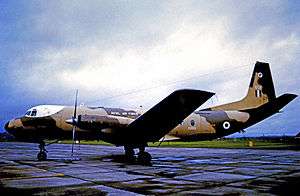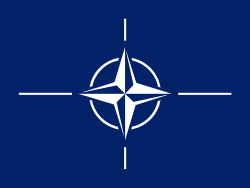Hawker Siddeley Andover
| HS 780 Andover | |
|---|---|
 | |
| Andover C1 | |
| Role | Transport aircraft |
| Manufacturer | Hawker Siddeley |
| First flight | 9 July 1965 |
| Primary users | Royal Air Force Royal New Zealand Air Force 748 Air Services |
| Number built | 37 |
| Developed from | Hawker Siddeley HS 748 |
The Hawker Siddeley HS 780 Andover is a twin-engined turboprop military transport aircraft produced by Hawker Siddeley for the Royal Air Force developed from the Avro-designed HS 748 airliner. The Andover was named after the Avro Andover, a Royal Air Force (RAF) biplane transport used for medical evacuation between the first and second world wars; and RAF Andover, where trials of the aircraft were partially carried out. The Andover had a kneeling landing gear to make ramp loading easier.
Design and development
At the start of the 1960s the Royal Air Force issued a requirement for a medium tactical freighter and Avro started work on a military variant of the Dart-powered twin-engined Avro 748 airliner. Handley Page also proposed a variant of the Handley Page Herald to meet the same requirement and both types were tested by the Air Force in February 1962 at Martlesham Heath in Suffolk. A prototype Avro 748 Srs 2 was used for the trials.
The RAF decided to order a military variant of the 748, designated by Avro as the Avro 780; and the original Avro 748 prototype was modified with an upswept rear fuselage and rear loading ramp as the Avro 748MF to test the military configuration. It had more powerful Dart Mk 301s engines and a unique kneeling landing gear was fitted. In April 1963 the Royal Air Force ordered 31 aircraft and these were designated the Andover C.1 by the RAF. The 748MF first flew from Woodford Aerodrome on 21 December 1963. The aircraft had larger four-bladed propellers than the 748 which required a greater distance between the engines and the fuselage, although the wingtips were reduced by 18 inches to maintain the same wingspan as the 748. A dihedral tailplane was also fitted to keep it clear of the propeller slipstream.
The first production Andover C.1 flew from Woodford on 9 July 1965 and the first four aircraft were used for trials and tests with both Hawker Siddeley and the Aeroplane and Armament Experimental Establishment at Boscombe Down. Following a release to service in May 1966 the fifth production aircraft was delivered to No. 46 Squadron RAF at RAF Abingdon in June 1966. Subsequent RAF types are the Andover CC.2 VIP transport and Andover E.3 electronic calibration aircraft.
Operational history


The Andover C.1 was flown for the first time on 9 July 1965. The first four examples were flown to RAF Boscombe Down for acceptance trials that year. The full contract of 31 aircraft were delivered and deployed to squadrons in Transport Command. These were No. 46 Squadron RAF at RAF Abingdon and later RAF Thorney Island, No. 52 Squadron RAF at RAF Seletar (Far East) and No. 84 Squadron RAF at RAF Sharjah (Middle East).[1]
There was a follow-on order placed with Hawker Siddeley for six aircraft that were designated CC.2, being a version of the standard HS 748, and these went initially to 21 Squadron at RAF Khormaksar. The squadron had these for six months before being disbanded when the aircraft went to 32 Squadron at RAF Northolt, designated the Metropolitan Communications Squadron. The aircraft were with 32 Squadron for over 18 years including some time spent on detachment at RAF Bruggen (Germany).[1]
Three of the RAF Andovers continued to fly into the second decade of the 21st century; one C.1 with the Empire Test Pilots' School and one C.1 with the Heavy Aircraft Test Squadron of the Joint Test and Evaluation Group. The remaining aircraft was a modified C.1 converted for photo-reconnaissance, the Andover C.1(PR), serial number XS596; the UK-designated aircraft under the Treaty on Open Skies. All three were based at RAF Boscombe Down.
The Royal New Zealand Air Force operated ten aircraft from 1976, acquired from the RAF while still relatively new. These saw service with UN missions to Somalia and on the Iran-Iraq border, and in disaster-relief work in the Pacific. The type was retired from service in 1998. The main difficulty with their service in New Zealand was their limited range – 1,000 nautical miles (1,900 km) of Pacific Ocean separate New Zealand from its nearest neighbours. New Zealand's Andovers were purchased to replace the Bristol Freighter which had even shorter range.
Variants
- Avro 748MF
- Prototype Avro 748 converted to military prototype which included an upswept rear fuselage and rear loading ramp and unique kneeling landing gear.
- Andover C.1
- First production series for RAF, 31 aircraft built.
- Andover C.1(PR)
- Two C1 aircraft was converted for Photographic Reconnaissance duties.
- Andover CC.2
- Not a variant of the cargo/transport Andover but a VIP transport version of the HS 748.
- Andover E.3 / E.3A
- Seven C.1 aircraft were converted for radio and airport nav aid calibration. Four aircraft were equipped with an inertial referenced flight inspection system (IRFIS) and were designated E3. The other three aircraft didn’t have this equipment installed, and were designated E3A.
Operators
Military operators
 NATO
NATO- One Royal Air Force aircraft was loaned to NATO and based at Oslo, Norway for use by the Commander Air Force North.
 New Zealand
New Zealand
- Royal Air Force
- No. 21 Squadron RAF used one aircraft in 1967
- No. 32 Squadron RAF based at RAF Northolt used for VIP transport and communications work.
- No. 46 Squadron RAF based at RAF Abingdon and later RAF Thorney Island operated 19 different aircraft between 1966 and 1970.
- No. 48 Squadron RAF based at RAF Changi used for VIP transport between 1969 and 1970
- No. 51 Squadron RAF
- No. 52 Squadron RAF based at RAF Seletar and later RAF Changi between March 1967 and December 1969
- No. 60 Squadron RAF
- No. 84 Squadron RAF based at RAF Sharjah, operated Andovers (replacing the Blackburn Beverley) from 1967 to 1971 mainly in a search and rescue role in the Gulf area.
- No. 115 Squadron RAF based at RAF Brize Norton later RAF Benson, operated Andovers (replacing the Armstrong Whitworth AW.660 Argosy) from 1976 in the radio aids calibration role.
- No. 242 Operational Conversion Unit RAF
- Queen's Flight RAF
- Empire Test Pilots' School
- Royal Aircraft Establishment
- Hunting Aviation
- Military Flight Checking Unit
Civil operators
Both former RAF and RNZAF[2] aircraft were later sold to civil operators, mainly in Africa. As of July 2010 a total of six ex-military Andovers remained in commercial service, operated by:[3]
- Air Kasai (1)
- Air Transport Office (1)
- International Trans Air Business (2)
- 748 Air Services (2)
As of July 2013 only one Andover remained in commercial service, operated by Kenyan company Wilken Aviation.[4] Said aircraft was damaged beyond repair in a non fatal accident at Malakal Airport in South Sudan on 10 November 2015, leaving no aircraft of the type in commercial service.[5]
Aircraft on display
As well as the small number of Andovers which are still flying, the following aircraft are on public display:
New Zealand
- Andover CC.1 serial NZ7621, a former Royal Air Force aircraft sold to the Royal New Zealand Air Force in 1977, is on display at the Royal New Zealand Air Force Museum in Christchurch.
United Kingdom
- Andover E.3A serial XS639, a former navigation aid calibration Andover, is exhibited in the Royal Air Force Museum Cosford.
Specifications (Andover C.1)
Data from Jane's All The World's Aircraft 1966–67.[6]
General characteristics
- Crew: two–three
- Capacity: 52 troops, 40 paratroops or 24 stretcher cases
- Payload: 14,365 lb (6,546 kg)
- Length: 78 ft 0 in (23.77 m)
- Wingspan: 98 ft 3 in (29.95 m)
- Height: 30 ft 1 in (9.15 m)
- Wing area: 831.4 ft² (77.2 m²)
- Aspect ratio: 11.55:1
- Empty weight: 29,324 lb (13,301 kg)
- Max. takeoff weight: 51,000 lb (23,133 kg)
- Powerplant: 2 × Rolls-Royce Dart RDa.12 Mk 201 turboprop, 3,245 eshp (2,421 kW) each
Performance
- Maximum speed: 320 mph (278 knots, 515 km/h) at 15,000 ft (4,570 m)
- Cruise speed: 270 mph (235 knots, 430 km/h)
- Stall speed: 90 mph (78 knots, 145 km/h) (flaps and wheels down)
- Range: 1,425 miles (1,239 nmi, 2,300 km) (fuel for 230 mi (370 km) diversion and 30 min stand-off)
- Service ceiling: 24,000 ft (7,300 m)
- Rate of climb: 1,200 ft/min (6.1 m/s)
See also
- Related development
- Aircraft of comparable role, configuration and era
- Related lists
References
- 1 2 Jefford
- ↑ New Zealand Military Aircraft Serial Numbers Hawker Siddeley HS.748MF Andover C.1
- ↑ Flight International 2010 World Airliner census retrieved 3 September 2010
- ↑ "2013 World Airliner Census", p. 48.
- ↑
- ↑ Taylor 1966, pp. 152–154.
- "World Airliner Census". Flight International, Volume 184, Number 5403, 13–19 August 2013, pp. 40–58.
- JEFFORD, RAF Squadrons 2nd edition, 2001
- Taylor, John W. R. Jane's All The World's Aircraft 1966–67. London: Sampson Low, Marston & Company, 1966.
External links
| Wikimedia Commons has media related to Hawker Siddeley Andover. |
- RAF Museum Andover page
- Various RAF Andover photos, including the unique and still-serving Andover C1 (PR)
- RNZAF Museum Andover page
- New Zealand Military Aircraft Serial Numbers Hawker Siddeley HS.748MF Andover C.1